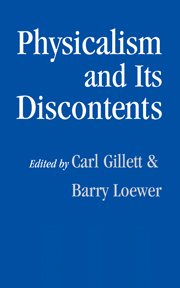Book contents
- Frontmatter
- Contents
- Contributors
- Preface
- Part I Physicalism
- Part II Physicalist Discontents
- Part III Physicalism and Consciousness: A Continuing Dialectic
- 13 Mental Causation and Consciousness: The Two Mind-Body Problems for the Physicalist
- 14 How Not to Solve the Mind-Body Problem
- 15 Deconstructing New Wave Materialism
- 16 In Defense of New Wave Materialism: A Response to Horgan and Tienson
- 17 Physicalism Unfalsified: Chalmers's Inconclusive Conceivability Argument
- References
- Index
17 - Physicalism Unfalsified: Chalmers's Inconclusive Conceivability Argument
Published online by Cambridge University Press: 02 November 2009
- Frontmatter
- Contents
- Contributors
- Preface
- Part I Physicalism
- Part II Physicalist Discontents
- Part III Physicalism and Consciousness: A Continuing Dialectic
- 13 Mental Causation and Consciousness: The Two Mind-Body Problems for the Physicalist
- 14 How Not to Solve the Mind-Body Problem
- 15 Deconstructing New Wave Materialism
- 16 In Defense of New Wave Materialism: A Response to Horgan and Tienson
- 17 Physicalism Unfalsified: Chalmers's Inconclusive Conceivability Argument
- References
- Index
Summary
Let a conceivability argument be any argument that aims to refute physicalism by showing that some claim that physicalism must treat as necessary is not in fact necessary because its negation is conceivable and hence genuinely possible. According to conceivability arguments in the recent tradition, it is conceivable that so-and-so iff the thought that so-and-so can be entertained without explicit contradiction or the sense of conceptual blockage one has (albeit to an unusually intense degree) in attempting to entertain the negation of the claim that two is a number. According to such arguments, the claim that it is assumed physicalism must treat as necessary is a certain more or less immediate consequence of any physicalist type-identity claim whereby some nonphysical property – some property expressible in nonphysical vocabulary – is identified with either a physical property or a physically realized functional property. So suppose the (nonphysical) property of being N is identified with the (physical or functional) property of being P. Then, on the assumption that the identity statement is formed using rigid designators and that such identity statements are necessary, it follows that, necessarily, an object is N iff it is P. But if, as the argument claims, it is conceivable, and hence possible, that something should be N but not P (or P but not N), then it is false that, necessarily, an object is N iff it is P, and hence false that being N just is being P.
But traditional conceivability arguments of this sort fail. Even though it is surely conceivable, in the sense specified, that something should be N but not P, the real possibility that something should be N but not P just does not follow.
- Type
- Chapter
- Information
- Physicalism and its Discontents , pp. 331 - 349Publisher: Cambridge University PressPrint publication year: 2001
- 5
- Cited by



